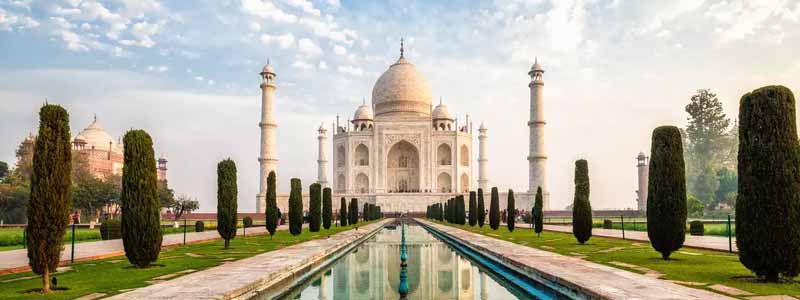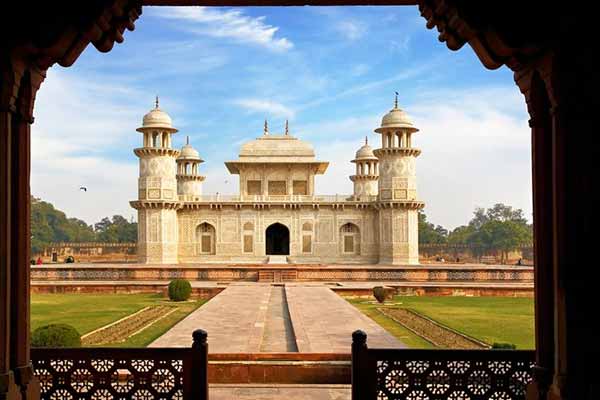Top 6 Places to See in Agra The Taj Mahal is a landmark of India, attracting millions of visitors each year to the city of Agra. This breathtaking landmark is everything you’ve expected it to be. Though most visitors are eager to get out of Agra’s obnoxious touts and exhausting crowds as soon as they leave the Taj Mahal, you can consider staying a little longer.
The Taj Mahal is just one of the many incredible sights to see in Agra. You can visit the historically important Agra Fort, the impressively beautiful Tomb of Itimad-ud-Daulah, Fatehpur Sikri, which houses one of India’s largest mosques, and Mehtab Bagh, a serene park in the shadows of the Taj Mahal.
Animal lovers, take note: Agra is home to two compassionate wildlife projects (the Agra Bear Rescue Center and the Elephant Protection and Care Center), both of which welcome visitors to learn about India’s most beloved animals.
Don’t be fooled by other tourists who say there’s nothing more to see in Agra but the Taj Mahal. With our list of the top attractions in Agra, you can schedule your trip to this heritage hotspot Top 6 Places to See in Agra.

Taj Mahal
The Taj Mahal is an ivory-white marble mausoleum on the Yamuna River’s south bank in Agra, India. The tomb of Shah Jahan’s favourite queen, Mumtaz Mahal, was commissioned in 1632 by the Mughal emperor Shah Jahan (reigned from 1628 to 1658). The tomb is the centrepiece of a complex that spans 17 hectares (42 acres) and includes a mosque and a guest house, It is surrounded on three sides by a crenellated wall and is located in formal gardens.
The mausoleum was largely finished in 1643, but other phases of the project took about ten years to complete. The Taj Mahal complex is thought to have been completed in its entirety in 1653, at a cost of about 32 million rupees at the time, In 2015, the figure would be about 52.8 billion rupees ($827 million). 20,000 artisans worked on the project, which was overseen by a board of architects headed by Ustad Ahmad Lahauri, the emperor’s court architect, Top 6 Places to See in Agra.
In 1983, the Taj Mahal was named a UNESCO World Heritage Site for being “India’s jewel of Muslim art.” and one of the most widely appreciated works of art in the world’s heritage.” Many consider it to be the finest example of Mughal architecture and a sign of India’s long history. Every year, 7–8 million people visit the Taj Mahal. It was named one of the Latest 7 Wonders of the World (2000–2007) winners in 2007.
Agra Fort
The Agra Fort is a historical fort in the Indian city of Agra. It served as the main residence of the Mughal emperors until 1638, when the capital was moved from Agra to Delhi. The fort of Agra has been designated as a UNESCO World Heritage Site. It’s about 2.5 kilometres northwest of the Taj Mahal, its more prominent sister monument. A more apt definition of the fort is that it is a walled fortress.
The triumphant Babur remained in the fort, in Ibrahim Lodi’s palace, after the First Battle of Panipat in 1526. In it, he later designed a baoli. Humayun, his successor, was crowned in the fort in 1530. Sher Shah Suri defeated him at Bilgram in 1540. The Suris held the fort until 1555, when Humayun reclaimed it. Hemu, Adil Shah Suri’s general, recaptured Agra in 1556 and followed Adil Shah Suri Its fleeing governor was captured by the Mughals in the Battle of Tughlaqabad in Delhi. Agra Fort’s Sheesh Mahal: The effect created by lighting candles in Agra Fort’s Sheesh Mahal.
Akbar made Agra his capital in 1558 after recognising the importance of its central position. This was a brick fort known as ‘Badalgarh,’ according to his historian, Abul Fazl. It was in a ruined state when Akbar had it reconstructed with red sandstone from the Barauli region of Rajasthan’s Dhaulpur district. The foundation was laid by architects, and it was constructed with bricks in the inner centre and sandstone on the exterior surfaces. Top 6 Places to See in Agra, For eight years, 4,000 workers worked on it every day, finally finishing it in 1573.
The site only became what it is today during the reign of Akbar’s grandson, Shah Jahan. In memory of his beloved, Mumtaz Mahal, Shah Jahan built the magnificent Taj Mahal. Unlike his grandfather, Shah Jahan preferred white marble for his houses. He demolished some of the fort’s older structures in order to build his own.
Shah Jahan was deposed and imprisoned in the fort by his uncle, Aurangzeb, near the end of his life. Shah Jahan is said to have died in Muasamman Burj, a tower with a marble balcony overlooking the Taj Mahal.
Fatehpur Sikri
Between 1572 and 1585 AD, Mughal emperor Akbar established Fatehpur Sikri as his capital. It was built out of red sandstone. The emperor, who desired a son, is said to have travelled to Sikri to seek the blessing of sufi saint Sheikh Salim Chishti. He was soon blessed with a son, prompting him to make this his capital, erecting a lovely mosque and three palaces, one for each of his three favourite women. Fatehpur Sikri, or Victory City, was the name he gave to the city. Salim was the name he gave to his son after the saint who had blessed him.
Fatehpur Sikri, which is built on a stony hill, is steeped in local legend. According to legend, it was long before Akbar made it his capital Babur, the Mughal emperor, called the city shukri (thanks) in honour of the locals who assisted him in winning the Battle of Khanwa in 1527 against Rana Sanga, a Rajput ruler from Mewar. After capturing Gujarat, his grandson, Emperor Akbar, founded the Buland Darwaza, which gave the city its current name.
The temples of Fatehpur Sikri reverberate with legends and mediaeval anecdotes. For eg, it’s thought that the emperor will play the eponymous game with his queens in a structure called Aankh Michauli (blind man’s buff). Another game, Pachisi, is named after a large sandstone courtyard nearby. Pachisi is a life-sized variant of the Indian board game. According to legend, the emperor played this game with women standing in for the pieces, Top 6 Places to See in Agra.
The Jama Masjid, one of India’s largest mosques, was built in 1648 AD by Mughal emperor Shah Jahan’s daughter, Jahanara Begum, and features Iranian architectural elements. The Diwan-i-Khas, Mariyam’s Tomb, and Birbal’s Palace are among the other monuments in this region. The emperor and his wives are said to have seen Tansen, one of the most well-known court musicians of all time, perform at Panch Mahal, a four-story columnar building.
Salim Chishti’s tomb, which is at the centre of Fatehpur Sikri’s plot, Thousands of tourists visit this white oasis in the midst of red sandstone. Devotees also come from far and wide with their ‘mannats,’ or wishes, and tie a string for each wish, hoping that the sufi saint will reward them and make their wishes come true. The death anniversary of Sheikh Salim Chishti is known as ‘Urs,’ and it involves a ceremony held here that is attended by devotees from all over the world.
Mehtab Bagh
Mehtab Bagh, or Moonlight Garden, is a popular destination for photographers in Agra. The Taj Mahal is most common among tourists during the early morning hours, when they can see it at sunrise. The Taj Mahal is said to be most beautiful in the morning. However, discerning viewers say that during sunset, the Taj Mahal offers a stunning and unforgettable view across the Yamuna River from Mehtab Bagh. Mehtab Bagh is on the left bank of the Yamuna River, directly across from the Taj Mahal. The Taj Mahal is directly across the street from the garden complex, which is a large square measuring approximately 300m X 300m.
On the southern periphery of the excavation, a large octagonal tank was uncovered, as well as ‘baradaris’ or pavilions on the east and west, At the middle is a small octagonal tank, with a doorway on the northern wall. 25 fountains, tanks, pavilions, a black marble plinth, and Aurangzeb’s letter to Shah Jahan describing a destructive flood in the 17th century were discovered during excavation at the site. According to some historians, the black marble structure was an effort by Shah Jahan to construct a Taj Mahal-like structure before he was seduced by Aurangz.
More than 25 species of erosion-resistant plants have been planted here to avoid persistent erosion caused by the Yamuna’s flood. With the passing of time, Mehtab Bagh has begun to draw a large number of visitors. It’s about 12 kilometres from Agra’s city centre.
Tomb of Ltimad-ud-Daulah
The Tomb of Itmad-ud-Daulah is one of the city of Agra’s most spectacular architectural wonders. The Taj Mahal is said to have been inspired by this structure. It is known as the “Baby Taj Mahal” because of this. Many visitors come to Agra to see the Taj Mahal, but they also want to see Itmad-ud-Tomb. Daulah’s
Despite their similarities, Itimad-Ud-tomb, Daulah’s with marble lattice screens and fine carvings, is considered a more delicate piece of art than the Taj Mahal. This was the first of many tombs built along the Yamuna River’s banks. If you’re in Agra, you can see this unique structure, which serves as the foundation for any marble monument that glorifies Top 6 Places to See in Agra.
Akbar’s Tomb, Agra
The Akbar’s Tomb is located on 119 acres of land in Sikandra, a suburb of Agra in the Indian state of Uttar Pradesh. The Akbar Tomb is a magnificent work of Mughal architecture from the time period, and it is an excellent design and construction. All inside the Tomb of Akba is fascinatingly crafted, starting with the ceiling and continuing through the walls and finishing with the door panels. And the Mughal Empire’s architectural expertise is manifested in the form of a massive Tomb.
The storey of Akbar’s Tomb is not the same as the Taj Mahal’s. The Taj Mahal was built for Shahjahan’s wife Mumtaj, so it is especially Mumtaz Mahal’s mausoleum. However, Badshah Akbar himself started the building of Akbar’s Tomb in Agra to hold his sepulture. Just a few Tombs of this kind exist in the world, and only a few of them have such a fascinating storey behind their creation.
For security purposes, the actual Tomb of Akbar the Great is located in the basement, which is sadly not accessible to tourists. Panels, air vents, and an open door in the basement house the actual body of Mughal Emperor Akbar, as per mughal custom.
The entire complex of Akbar’s Tomb is surrounded on all sides by thick walls and has four gates, but only the southern gate, which is the largest and enriched with extensive works of architecture, is used for entry and exit; the other gates are nearly destroyed. Within Akbar’s Tomb, there is a large garden where you can see antelope, monkeys, and peacocks.
The entire complex of Akbar’s Tomb is surrounded on all sides by thick walls and has four gates, but only the southern gate, which is the largest and enriched with extensive works of architecture, is used for entry and exit; the other gates are nearly destroyed. Within Akbar’s Tomb, there is a large garden where you can see antelope, monkeys, and peacocks.
